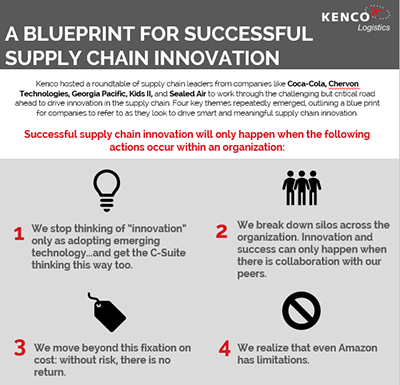The current state of supply chain innovation will be examined by a host of industry professionals at the Warehousing Education and Research Council's (WERC) annual conference in May. Among those experts presenting their views will be Kristi Montgomery, vice president of innovation for Kenco.
Earlier this week she shared some of the results of Kenco's “blueprint” for innovation in an exclusive interview with Supply Chain Management Review.
“Supply chain is the backbone of a company: strong, flexible and supporting so many parts of the business,” says Montgomery. “But in many ways, they're also fragile: too much change or pressure and they'll fracture, with wide-spread impact throughout the organization. Like all parts of business, new technologies, new processes and new ways of thinking will make them stronger, more efficient and more powerful.”
According to Montgomery, there's both an art and science to how managers drive innovation in supply chains.
“At CSCMP Edge 2017, Kenco hosted a roundtable of supply chain leaders from companies like Coca-Cola, Chervon Technologies, Georgia-Pacific, Kids II, and Sealed Air to work through the challenging but critical road ahead,” she says. “While the discussion was set up to be open-ended, four key themes repeatedly emerged, outlining a blue print for companies to refer to as they look to drive smart and meaningful supply chain innovation.”
Montgomery says successful supply chain innovation will only happen when the following actions occur within an organization:
1.) Stop thinking of “innovation” only as adopting emerging technology…and get the C-Suite thinking this way too.
It is so easy to get seduced by the latest buzzword – IoT; drones; driverless trucks. These technologies can and will have a massive impact on our work, but that won't happen today. Real and meaningful impact will come from widespread deployment of technologies and processes that have been proven and tested. Successful supply chain leaders will pilot these bleeding-edge technologies as they get fine-tuned into maturity, and use those case studies to refine our roadmaps – but they will also focus on and celebrate the gains they achieve from process improvements and enhancing current technologies.
2.) Break down silos across the organization. Innovation and success can only happen when there is collaboration with our peers.
Open communication across teams breeds innovation – from streamlining processes, identifying new opportunities, and simply creating better ways to accomplish tasks. By breaking down silos to enable idea and information sharing, supply chain leaders can create innovative solutions that not only impact the bottom line, but also improve customer communications, leading to better partnerships.
3.) Move beyond this fixation on cost: without risk, there is no return
Innovation is an investment for all companies; too often they are so fixated on costs that the process to innovate is halted, including identifying and supporting the teams' talent to work on the creative process. We've heard the adage, “Fail Fast, Fail Cheap.” For companies practicing this, coming up with new ideas will happen sooner, leading to more innovation while requiring less iterations as the team will know what worked and what didn't – saving valuable investment dollars. Ultimately, if the industry is truly being disrupted, innovation needed to happen yesterday to stay ahead of competitors.
4.) Realize that even Amazon has limitations
It's impossible to ignore the impact of “the Amazon Effect” – but for supply chain leaders making it their goal to become more like Amazon or a company of similar magnitude, it's time to rethink this strategy. Amazon's innovation model, which supposedly has to have 4,500 employees focused on research and development of innovations, is an impressive approach, but it shouldn't necessarily be your company's end goal. Instead, we need to realize that Amazon is one model of what a successful, innovative supply chain leader looks like – not necessarily the blueprint – and that there are other approaches to become as impactful.
“As supply chain leaders, we have the power to influence and transform the way innovation is developed, nurtured and implemented in our industry,” says Montgomery. “The future of the supply chain is based on collaboration, connectivity and agility, and most important, being resilient.”
Related Kenco Infographic:

SC
MR


Latest Supply Chain News
- Balancing green and speed: Home delivery insights from the pandemic era
- AdventHealth named top healthcare supply chain by Gartner
- Geopolitical readiness in supply chains: Strategic challenges for leaders
- Unlocking retention: The role employee engagement plays
- Can supply chain managers embrace an entrepreneurial mindset?
- More News
Latest Podcast

 Explore
Explore
Business Management News
- Balancing green and speed: Home delivery insights from the pandemic era
- AdventHealth named top healthcare supply chain by Gartner
- Unlocking retention: The role employee engagement plays
- Can supply chain managers embrace an entrepreneurial mindset?
- Challenges to ESG reporting
- With capacity to spare, logistics real estate demand remains subdued
- More Business Management
Latest Business Management Resources

Subscribe

Supply Chain Management Review delivers the best industry content.

Editors’ Picks





